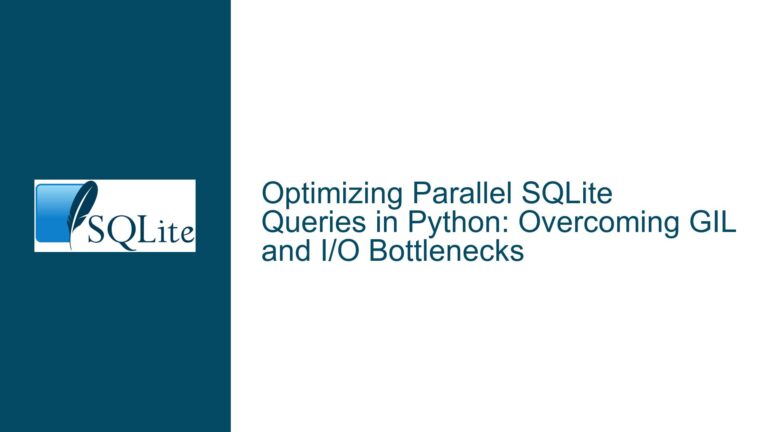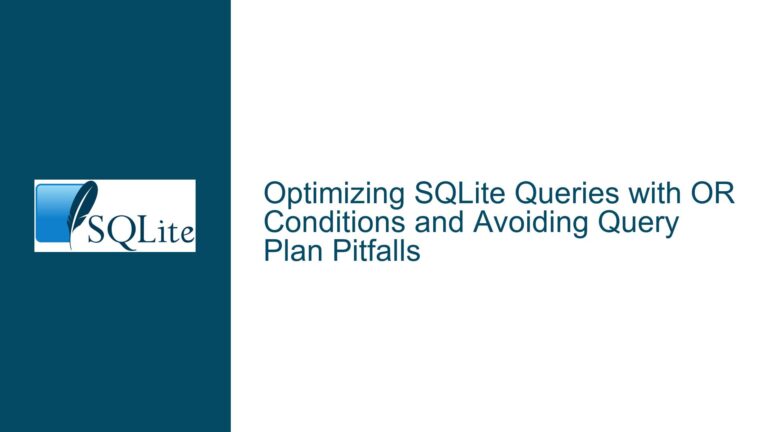Tracking Disk I/O Metrics in SQLite: Diagnosing Missing VFSStat Data
Issue Overview: Missing or Unexpected Results from VFSStat Extension
The core challenge revolves around leveraging SQLite’s vfsstat extension to monitor disk I/O metrics during database operations. Users expect the extension to report detailed page read/write counts, file system interactions, and other I/O-related statistics. However, when executing a test script involving table creation, data insertion, indexing, and maintenance commands, the vfsstat table only registers a single entry (randomness with a count of 1), contrary to expectations of observing multiple I/O events. This discrepancy raises questions about the extension’s functionality, configuration, or compatibility with specific environments (e.g., Windows 10 with Visual Studio 2019). The absence of expected metrics complicates performance analysis, query optimization, and low-level debugging efforts.
Key operational details include:
- The
vfsstatextension intercepts Virtual File System (VFS) layer calls to track I/O activity. - Metrics are stored in the
vfsstatvirtual table, which categorizes events by file handle and operation type. - The test script includes operations expected to trigger disk I/O, such as
INSERT,CREATE INDEX, andVACUUM. - The environment uses a 32-bit build of SQLite and the
vfsstat.dllextension compiled for Windows.
Possible Causes: Why VFSStat Fails to Report I/O Activity
The absence of expected I/O metrics in the vfsstat table can stem from multiple factors, ranging from improper extension initialization to platform-specific VFS behavior.
1. Incorrect VFS Wrapping or Initialization
The vfsstat extension operates by wrapping the default VFS layer. If the extension fails to register itself as the active VFS, SQLite will bypass it, resulting in no metrics collection. This can occur due to:
- Compilation errors in
vfsstat.dll, such as missing symbols or incorrect linkage. - Failure to load the extension at runtime (e.g., using
.load vfsstat.dllwithout proper path specification). - Platform-specific VFS naming conventions (e.g., Windows uses
win32as the default VFS, while Unix systems useunix).
2. Journaling Modes Bypassing I/O Tracking
The test script sets the journal mode to WAL (Write-Ahead Logging), which alters how SQLite interacts with disk files. WAL mode uses shared memory structures (-shm and -wal files) and may reduce synchronous writes, potentially bypassing the instrumentation provided by vfsstat. Similarly, using PRAGMA journal_mode=MEMORY directs journal operations to RAM, eliminating disk I/O for rollback journals.
3. File Handle Isolation in Windows
On Windows, SQLite often opens additional file handles for locking and synchronization, which may not be tracked by vfsstat if the extension does not account for platform-specific file management nuances. For example, the win32 VFS uses LockFileEx and UnlockFileEx for concurrency control, which might not trigger the same I/O events as Unix-style file locks.
4. Extension Compatibility with SQLite Versions
The vfsstat extension is part of SQLite’s source tree but may not be actively maintained. If the extension is compiled against an older SQLite version (e.g., 3.36.0) without adjustments for newer VFS APIs, certain I/O methods might not be intercepted.
5. Misinterpretation of Tracked Metrics
The vfsstat extension categorizes I/O operations into specific stat types (e.g., read, write, sync). If the test script primarily performs operations that fall outside these categories (e.g., memory-mapped I/O in WAL mode), the extension will not log them. The sole randomness entry corresponds to the randomblob() function call, which explicitly invokes the OS’s random number generator, confirming that the extension is partially functional.
Troubleshooting Steps, Solutions & Fixes: Resolving VFSStat Data Gaps
1. Validate Extension Loading and VFS Registration
Begin by confirming that the vfsstat extension is loaded and actively intercepting VFS calls.
Step 1: Verify Extension Load
Execute.load vfsstat.dllwith an absolute path to ensure the DLL is correctly located:.load C:\path\to\vfsstat.dllCheck for error messages indicating load failures, such as missing dependencies or incompatible architectures.
Step 2: Confirm Active VFS
Query the current VFS usingPRAGMA vfs_list;. The output should include a VFS namedvfslogorvfsstat, indicating the extension is active. If the default VFS (e.g.,win32) is listed, the extension has not successfully wrapped it.Step 3: Recompile with Debug Symbols
Rebuildvfsstat.cwith debugging enabled to inspect initialization routines. Add-DSQLITE_DEBUGto compiler flags and use a debugger to step throughsqlite3_vfsstat_register(), ensuring it callssqlite3_vfs_register()correctly.
2. Adjust Journaling and Synchronization Settings
Modify the test script to use settings that enforce synchronous disk writes, bypassing optimizations that might obscure I/O activity.
Step 1: Disable WAL Mode
AvoidPRAGMA journal_mode=WAL, as WAL relies on memory-mapped I/O and shared buffers. UseDELETEmode instead:PRAGMA journal_mode=DELETE; PRAGMA synchronous=FULL;Step 2: Force Checkpoint in WAL Mode
If WAL is required, manually trigger a checkpoint to flush the WAL file to the main database:PRAGMA wal_checkpoint=TRUNCATE;
3. Instrument Specific I/O Operations
Design a targeted test script to isolate I/O events that vfsstat should detect.
Step 1: Direct Page Reads
Force SQLite to read pages from disk by evicting the cache:PRAGMA cache_size=0; SELECT * FROM sqlite_schema;Step 2: Explicit File Syncs
Invokesqlite3_db_cacheflush()orPRAGMA schema.synchronousto trigger sync operations.
4. Inspect VFSStat Source Code for Coverage Gaps
Review the vfsstat.c implementation to identify untracked VFS methods. Key functions to instrument include:
xRead,xWrite,xTruncatefor basic I/O.xSync,xLock,xUnlockfor synchronization.xFileSize,xAccessfor metadata operations.
If these methods are not overridden by the vfsstat VFS wrapper, corresponding I/O events will not appear in the table.
5. Platform-Specific Workarounds for Windows
Adapt the extension or test environment to account for Windows file handling.
Step 1: Use
win32VFS Explicitly
Register thevfsstatwrapper for thewin32VFS specifically:sqlite3_vfs_register(sqlite3_vfs_find("win32"), 1);Step 2: Monitor Auxiliary Files
Include-shmand-walfiles in thevfsstatoutput by modifying the extension to track all file handles, not just the main database.
6. Alternative Metrics Collection Strategies
If vfsstat proves unreliable, consider alternative approaches:
SQLite’s Status Counters
Usesqlite3_status()orPRAGMA schema.statsto retrieve high-level I/O metrics.External Tools
Employ OS-level monitoring tools like Windows Performance Monitor (perfmon) or Process Monitor (procmon) to trace SQLite’s file activity.
7. Patch VFSStat for Enhanced Tracing
Modify vfsstat.c to log all intercepted calls to a debug console, confirming whether specific operations are being tracked. Add printf statements within each VFS method wrapper:
static int vfsstatWrite(
sqlite3_file *pFile,
const void *pBuf,
int iAmt,
sqlite3_int64 iOfst
){
VfsStatFile *p = (VfsStatFile*)pFile;
printf("Write intercepted: %d bytes at offset %lld\n", iAmt, iOfst);
return p->pReal->pMethods->xWrite(p->pReal, pBuf, iAmt, iOfst);
}
Recompile and rerun the test script to observe debug output.
8. Validate Compilation Flags and Dependencies
Ensure the vfsstat.dll build process includes all necessary SQLite amalgamation components and uses compatible runtime libraries. For Visual Studio 2019:
- Link against the static SQLite library (
sqlite3.lib) to avoid symbol mismatches. - Use
/MDor/MTruntime flags consistent with the SQLite build.
9. Test with Minimal Configuration
Strip down the test script to eliminate variables:
.load vfsstat.dll
UPDATE vfsstat SET count=0;
CREATE TABLE t1(a INTEGER PRIMARY KEY, b BLOB);
INSERT INTO t1(b) VALUES(randomblob(4096));
SELECT * FROM t1;
DROP TABLE t1;
SELECT * FROM vfsstat WHERE count>0;
If this minimal case still shows no I/O metrics, the issue lies in the extension or environment.
10. Cross-Platform Validation
Test the same vfsstat extension on a Unix-like system (e.g., Linux or macOS) to determine whether the problem is Windows-specific. If metrics appear correctly there, focus troubleshooting on Windows VFS differences.
By systematically addressing these areas, users can resolve discrepancies in vfsstat output, ensuring accurate I/O metrics collection for SQLite performance analysis.





